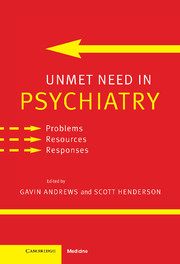Book contents
- Frontmatter
- Contents
- List of Contributors
- Preface
- Part I Unmet need: defining the problem
- Part II Unmet need: general problems and solutions
- Part III Unmet need: people with specific disorders
- Part IV Unmet need: specific issues
- Introduction
- 22 Unmet need in mental health service delivery: children and adolescents
- 23 Assessing psychopathology among children aged four to eight
- 24 Unmet need in Indigenous mental health: where to start?
- 25 Health systems research: a pragmatic model for meeting mental health needs in low-income countries
- 26 Disablement associated with chronic psychosis as seen by two groups of key informants: patients and mental health professionals
- 27 The assessment of perceived need
- 28 Public knowledge of and attitudes to mental disorders: a limiting factor in the optimal use of treatment services
- Part V Unmet need: conclusion
- Index
27 - The assessment of perceived need
from Part IV - Unmet need: specific issues
Published online by Cambridge University Press: 21 August 2009
- Frontmatter
- Contents
- List of Contributors
- Preface
- Part I Unmet need: defining the problem
- Part II Unmet need: general problems and solutions
- Part III Unmet need: people with specific disorders
- Part IV Unmet need: specific issues
- Introduction
- 22 Unmet need in mental health service delivery: children and adolescents
- 23 Assessing psychopathology among children aged four to eight
- 24 Unmet need in Indigenous mental health: where to start?
- 25 Health systems research: a pragmatic model for meeting mental health needs in low-income countries
- 26 Disablement associated with chronic psychosis as seen by two groups of key informants: patients and mental health professionals
- 27 The assessment of perceived need
- 28 Public knowledge of and attitudes to mental disorders: a limiting factor in the optimal use of treatment services
- Part V Unmet need: conclusion
- Index
Summary
Individuals make active decisions in pursuing patient careers, usually with choice as to whether they become consumers. Therefore, perceived need is relevant to an assessment of the dynamics of a service delivery system. The Australian National Survey of Mental Health and Well-Being collected data about these perceptions and decisions, which required a new questionnaire to be devised. This chapter presents something of the history of incorporation of this perspective into needs assessment, then describes the development of the instrument for the Australian Survey.
The major focus of this book is to encourage us to look closely at what constitutes need. We are all preoccupied with the prevalence of mental health disorders in populations. However, estimating prevalence is not the same as quantifying need. There are people who can be diagnosed but do not have mental health needs, and there are people who have needs, but who do not meet criteria for diagnosis. The concept of need has been difficult to define (Johnson, Thornicroft, Phelan & Slade, 1996; Marshall, 1994; Stevens & Gabbay, 1991). The notion of perceived need highlights the subjective and socially negotiated aspects of the nature of need (Slade, 1994a). Perceived need, then, can be seen as being closely linked with perceptions of mental health care, barriers to care, and the prevalence of untreated disorders.
An individual's perceptions of what is appropriate treatment may influence the acknowledgement of a problem.
Keywords
- Type
- Chapter
- Information
- Unmet Need in PsychiatryProblems, Resources, Responses, pp. 390 - 398Publisher: Cambridge University PressPrint publication year: 2000
- 12
- Cited by



